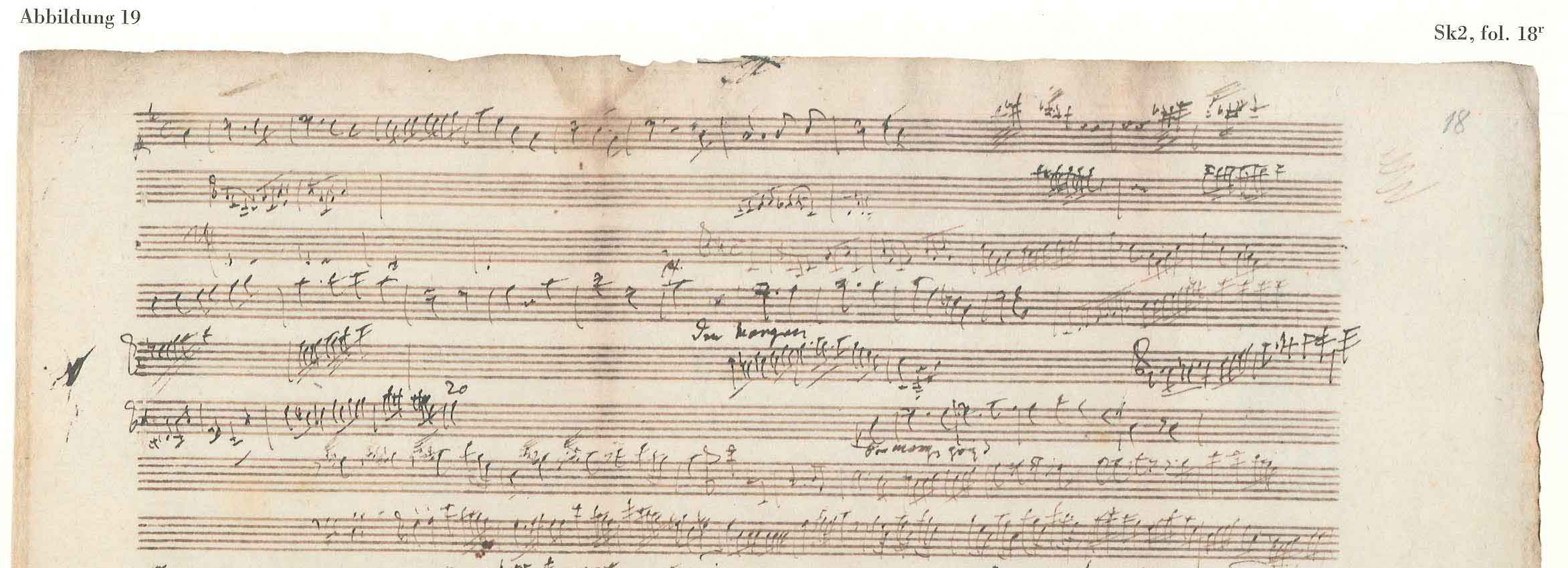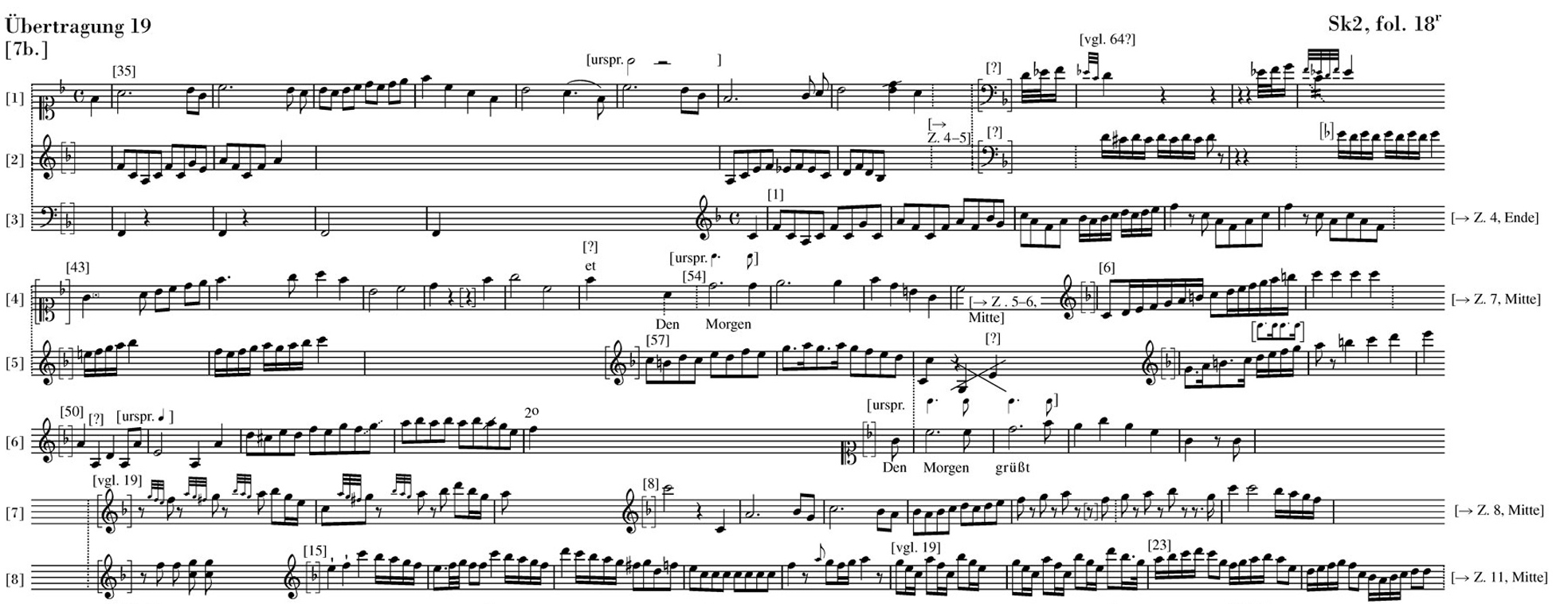It is probably well enough known that in the G. Henle publishing house there are not only the blue Urtext editions, but also major complete-edition volumes of works by Haydn, Beethoven and Brahms. Ultimately, in fact, these volumes also reliably ground our practical editions of these composers. But you may not have already realized that in these volumes, alongside the scores of all a composer’s works, you can also find earlier versions and even sketches – and perhaps many of you will even wonder what music sketches really are and for what reason they are published in a complete edition?
Well, just as it is in painting, so is it also in music: a sketch is the first record on paper of an idea, whether it is of a single motif or the course of an entire movement. In the compositional process, sketches stand between improvising at the piano on the one hand and working out a composition on the other, as we have imagined it in the case of Joseph Haydn. The painter Albert Christoph Dies, acquainted with Haydn, has described this in his Biographische Nachrichten über Joseph Haydn (1810) as follows: “At eight o’clock Haydn ate breakfast. Immediately afterwards he sat down at the piano and improvised for as long as he needed to find the ideas that served his purpose, which he at once put on paper: This is how the first sketches of his compositions came about […] At four o’clock he again went to his musical activity. He then took the morning’s sketching and scored it […].”
In this way the sketches first let us know very concretely the ideas on which Haydn had gone to work. By comparing sketches with what was written down later we can reconstruct how Haydn worked compositionally. The miracle of how an art work originates that we can track for a present-day artist such as Gerhard Richter in the current movie Gerhard Richter Painting can therefore also be experienced at least in parts for a composer dead already 200 years – if the sketches to his works have been preserved.
This if actually amounts to a very substantial constraint, because by nature sketches have a poor chance of being kept for posterity. Their purpose as ‘memory aids’ was ultimately fulfilled when a work was finished. After that they were mostly destroyed by the composer himself or otherwise disappeared. Also from Haydn we know of sketches to ‘only’ about 70 of his works. For many symphonies and string quartets there are only single pages or no longer any sketches at all. It is different in the case of the Creation: Here there are altogether 36 closely written pages containing a remarkable number of sketches that give insight into the Master’s workshop.
So, it is only from these pages that can we tell that the famous soprano aria “On mighty pens” originally had an entirely different melody. The five notated beginnings of the recitative “Our duty we performed now” make it clear that Haydn even pondered very carefully such apparently standardized musical phrases before opting for a variant. The three existing full-score sketches for the overture “The Representation of Chaos” show in turn how Haydn slowly developed the whole movement out of a basic idea initially outlined on only one page and garnished it with ever finer rhythmic and harmonic details.
For a historico-critical complete edition that would indeed make the historical ‘past’ of a composer’s oeuvre tangible, this is reason enough to document these earliest manifestations of a work just as carefully as the completely elaborated composition coming at the end of the process. It is only a question of how this documentation should look. Because the comparison with painting is inappropriate in one respect: Unlike in the case of a sketch for a painting, practically speaking, an untrained reader cannot readily decipher a sketch for a composition.
Haydn certainly wrote his sketches only for his own use; they are therefore much more difficult to read than his autographs (which indeed were already done for a musician or copyist who had to be able to read them without making mistakes). And he also specified in these sketches only what he absolutely needed to in the way of a memory aid for elaborating the piece. Elements that to him were obvious – such as, for example, clefs, key signature or the text of an aria – he did not need to record there at all. Finally, he did not always notate his ideas on such a sketch leaf absolutely ‘neatly’, one after the other, but used the leaf as a writing space divided in terms of formal aspects. It was, for instance, as if we were to write a long shopping list: at the top left, the bakery goods, under this, groceries from the supermarket, over in the right margin, special items such as flowers or books… Even though we thought of something else to add later, we would still sort it this way.
Haydn proceeds exactly the same way when he starts jotting down ideas for certain sections in various places on a page, then adds above and below alternatives to these. Then an entirely new solution occurs to him, which should though still be here on the page intended for this aria. And since now there is hardly a line still free, he simply begins writing again after an already notated section, and in the end squeezes his ideas into the last free space until the leaf is written so full that hardly anything can still be deciphered.
This is how it happens that to read within the right context what is jotted down on so many sketch leaves really requires a regular roadmap. For that reason, Haydn’s sketches are not (only) reproduced in facsimile in the Complete Edition published by the Joseph Haydn-Institut in Cologne, but are also transcribed in a clearly legible music notation. And this transcription is provided with the additional information that for Haydn was a matter of course: identifying movement and measure to which the entry refers; marking related staves or indicating that the notation continues elsewhere. Finally, a commentary supplies evidence as to the order in which the leaf was written and how the individual sections relate to one another.
Normally in the Haydn Complete Edition, sketches are reproduced in an appendix simply at the end of the full-score volume. In the case of the Creation, this transmission’s great boon implies a challenge to optimally process this – unique for Haydn – multiplicity of workshop material. The sketches are therefore published in a volume of its own (HN 5837) that in a real sense is not a volume at all, but a treasure trove, with individual books for the coloured facsimiles, the transcriptions and the commentary. Thus, the sketches preserved today in London, New York and Vienna can for the first time be read again in their ‘original’ relationship, the transcriptions and sketches directly compared with each other, and the accompanying commentary consulted. This way the reader is given the best-possible foundation for the study of Haydn’s sketches – for being able to have a little look into the workshop of a great Master. And we are especially happy that at this year’s International Music Fair in Frankfurt these efforts for the volume with the Creation sketches were rewarded by the distinction of being called “Best edition”.


